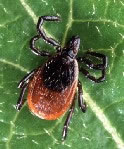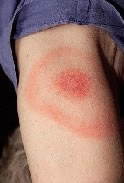Tick Bite
Tick Bite
Does this describe your symptoms? |
Click image for more info |
Definition
General Information
Lyme Disease
|
If not, see these topics
|
When to Call Your Doctor |
Call Your Doctor Now (night or day) If |
|
|
|
Call Your Doctor Within 24 Hours (between 9 am and 4 pm) If |
|
|
|
Call Your Doctor During Weekday Office Hours If |
|
|
|
Self Care at Home If |
|
|
HOME CARE ADVICE |
Home Care Advice for Tick Bite
Wood Tick Removal:
Use a pair of tweezers and grasp the wood tick close to the skin (on its head). Pull the wood tick straight upward without twisting or crushing it. Maintain a steady pressure until it releases its grip.
If tweezers are not available, use fingers, a loop of thread around the jaws, or a needle between the jaws for traction.
Note: covering the tick with petroleum jelly, nail polish or rubbing alcohol doesn't work. Neither does touching the tick with a hot or cold object.
Tiny Deer Tick Removal:
Deer ticks are very small and need to be scraped off with a credit card edge or the edge of a knife blade.
Place tick in a sealed container (e.g., glass jar, zip lock plastic bag), in case your doctor wants to see it.
Tick's Head Removal:
If the wood tick's head breaks off in the skin, it must be removed. Clean the skin. Then use a sterile needle to uncover the head and lift it out or scrape it off.
If a very small piece of the head remains, the skin will eventually slough it off.
Antibiotic Ointment: Wash the wound and your hands with soap and water after removal to prevent catching any tick disease. Apply an over-the-counter antibiotic ointment (e.g., bacitracin) to the bite once.
Expected Course: Tick bites normally do not itch or hurt. That is why they often go unnoticed.
Call Your Doctor If:
You can't remove the tick or the tick's head
Fever or rash occur in the next 2 weeks
Bite begins to look infected
You become worse
How to Prevent a Tick Bite
Prevention - General:
Prevention is important if you are hiking in tick-infested areas.
Wear long pants and a long shirt. Tuck your shirt into your pants. Tuck the cuffs of your pants into your socks or boots. Light-colored clothing is better because the ticks can be seen more easily.
Inspect your entire body and your clothing every couple hours. Ticks like to hide in your hair; so be certain to check your scalp, neck, armpits, and groin.
A shower at the end of a hike will help rinse off any tick that is not firmly attached.
Prevention with Insect Repellent - DEET:
DEET is a very effective tick repellent. It also repels mosquitoes and other bugs.
Apply to exposed areas of skin. Do not apply to eyes, mouth or irritated areas of skin. Remember to wash it off with soap and water when you return indoors.
Pregnant and breastfeeding women may use DEET. No problems have been reported. [Source: Insect Repellent Use and Safety, Centers for Disease Control and Prevention]
Be certain to read the package instructions on any product that you use.
Prevention with Insect Repellent for Your Clothing - Permethrin:
Permethrin-containing products (e.g., Duranon, Permanone, and Congo Creek Tick Spray) are highly effective mosquito repellents. They also repel ticks.
An advantage over using DEET is that they are applied to and left on clothing instead of skin. Apply it to clothes before putting them on. You can also put it on other outdoor items (shoes, mosquito screen, sleeping bags).
Do not apply permethrin to skin (Reason: it's rapidly degraded on contact with skin).
Be certain to read the package instructions on any product that you use.
And remember, contact your doctor if you develop any of the "Call Your Doctor" symptoms.
Updated:
March 22, 2017









